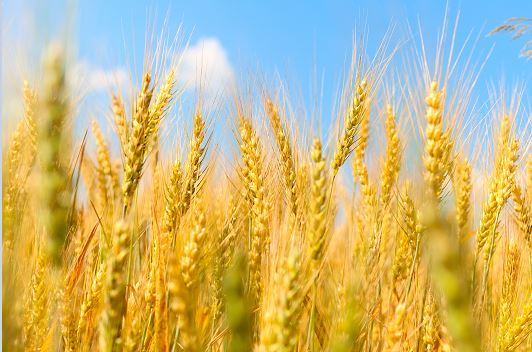Use of carrageenan for the reduction of deoxynivalenol contamination in wheat and barley kernels
DOI:
https://doi.org/10.20873/jbb.uft.cemaf.v9n1.ducattiPalabras clave:
DON, elicitation, FHB, Fusarium graminearum, Solieria chordalisResumen
Wheat and barley are among the more important staple foods for human and animal nutrition in the World. Nevertheless, these crops constantly suffer from the Fusarium Heat Blight disease, responsible for decrease in yields and the bioaccumulation of the trichothecene deoxynivalenol in kernels. Searching for alternatives to overcome these problems, a set of 14 trials involving wheat and barley cultivars over two consecutive harvest seasons (2018-2019) were carried out in the States of Santa Catarina and Rio Grande do Sul, Brazil. The tests consisted in the use of a carrageenan-rich product (Algomel Push®) produced from the red-algae Solieria chordalis in the rates of 1.0 and 2.0 L ha-1 sprayed at the beginning of the tillering stage. Overall, the use of carrageenan decreased DON contamination up to 34.64% and 35.74% when 1.0 and 2.0 L ha-1 of carrageenan was applied in wheat and barley, respectively. An increase in yield and kernels with better bromatological aspects were also seen after the use of carrageenan. Our findings suggest that the bioactive compounds found in the product, mostly carrageenan, have the ability of eliciting the plant’s mechanisms of defence and growth, and can be considered a potential option/tool for farmers and industries to cope with the problem of food quality in their mycotoxicological and bromatological aspects.
Key-words: DON; elicitation; FHB; Fusarium graminearum; Solieria chordalis
Citas
Berthiller F, Crews C, Dall’asta C, Saeger SD, Haesaert G, Karlovsky P, Oswald IP, Seefelder W, Speijers G, Stroka J. Masked mycotoxins: a review. Molecular Nutrition and Food Research, v.57, p.165-186, 2013. https://doi.org/10.1002/mnfr.201100764
Biomin, 2019. World Mycotoxin Survey 2019. 16 report. Available at: https://www.biomin.net/science-hub/world-mycotoxin-survey-impact-2020
Buerstmayr H, Legzdina L, Steiner B, Lemmens M, Variation for resistance to Fusarium head blight in spring barley. Eu-phytica, v.137, p.279-290, 2004. https://doi.org/10.1023/B:EUPH.0000040440.99352.b2.
Chi, Y.H.; Koo, S.S.; Oh, H.T.; Lee, E.S.; Park, J.H.; Phan, K.A.T.; Wi, S.D.; Bae, S.B.; Paeng, S.K.; Chae, H.B.; Kang, C.H.; Kim, M.G.; Kim, W.-Y.; Yun, D.-J.; Lee, S.Y. The Physiological Functions of Universal Stress Proteins and Their Molecular Mechanism to Protect Plants from En-vironmental Stresses. Frontiers in Plant Science, v. 10, p. 1-13, 2019. https://doi.org/10.3389/fpls.2019.00750
Dixon J, Braun HJ, Kosina T, Crouch J. 2009. Wheat facts and futures: 2009. 1st ed., Mexico: CIMMYT, 2009. 95 p.
Fesel PH, Zuccaro A. β-glucan: Crucial component of the fungal cell wall and elusive MAMP in plants. Fungal Genet-ics and Biology, v.90, p.53-60, 2016. http://dx.doi.org/10.1016/j.fgb.2015.12.004
Gonzáles A, Castro J, Vera J, Moenne A. Seaweed oligosac-charides stimulate plant growth by enhancing carbon and nitrogen assimilation, basal metabolism, and cell division. Journal of Plant Growth Regulators, v.32, p.443-448, 2013. https://doi.org/10.1007/s00344-012-9309-1
Marin S, Ramos AJ, Cano-Sancho G, Sanchis V. Mycotox-ins: Occurrence, toxicology, and exposure assessment. Food and Chemical Toxicology, v.60, p.218-237, 2013. https://dx.doi.org/10.1016/j.fct.2013.07.047
Mercier L, Lafitte C, Borderies G, Briand X, Esquerré-Tugayé MT, Fournier J. The Algal Polysaccharide carrageenans can act as an elicitor of plant defence. New Phytologist, v.149, p.43-51, 2001. https://doi.org/10.1046/j.1469-8137.2001.00011.x
Olmix Group. Guide to Mycotoxins: The Essentials. France: L’Imprimerie de Bretagne, 2018, 90 p.
Piacentini KC, Savi GD, Pereira MEY, Scussel VM. Fungi and the natural occurrence of deoxynivalenol and fumonisins in malting barley (Hordeum vulgare L.). Food chemistry, v.15, p.204-209, 2015. https://dx.doi.org/10.1016/j.foodchem.2015.04.101
Sangha J, Critchley AT, Prithiviraj B. Seaweeds (Macroalgae) and Their Extracts as Contributors of Plant Productivity and Quality: The Current Status of our Understanding. Advanc-es in Botanical Research, v.3, p.153-168, 2014. https://doi.org/10.1016/B978-0-12-408062-1.00007-X
Shukla OS, Borza T, Critchley AT, Prithiviraj B. Carragee-nans from Red Seaweeds as Promoters of Growth and Elici-tors of Defense Response in Plants. Frontiers in Marine Science, v.3, p.1-9, 2016. https://doi.org/10.3389/fmars.2016.00081
Stadnik MJ, Freitas MB. Algal polysaccharides as source of plant resistance inducers. Tropical Plant Pathology, v.39, p.111-118, 2014. https://doi.org/10.1590/S1982-56762014000200001
Wegulo AN. Factors influencing deoxynivalenol accumulation in small grain cereals. Toxins, v.4, p.1157-1180, 2012. http://dx.doi.org/10.3390/toxins4111157
Wu L, Qiu L, Zhang H, Sun J, Hu X, Wang B. Optimization for the production of Deoxynivalenol and Zearalenone by Fusarium graminearum using response surface methodolo-gy. Toxins, v.9, p.1-17, 2017. https://dx.doi.org/10.3390/toxins9020057

Descargas
Publicado
Cómo citar
Número
Sección
Licencia
Copyright (c) 2024 - Journal of Biotechnology and Biodiversity

Esta obra está bajo una Licencia Creative Commons Atribución 4.0 Internacional.
Los autores que publican en esta revista aceptan los siguientes términos:
Los autores mantienen los derechos autorales y conceden a la revista el derecho de primera publicación, con el trabajo simultáneamente licenciado bajo la LicenciaCreative Commons Attribution (CC BY 4.0 en el link http://creativecommons.org/licenses/by/4.0/) que permite compartir el trabajo con reconocimiento de la autoría y publicación inicial en esta revista.
Los autores tienen autorización para asumir contratos adicionales separadamente, para distribución no exclusiva de la versión del trabajo publicado en esta revista (ej.: publicar en repositorio institucional o como capítulo de libro), con reconocimiento de autoría y publicación inicial en esta revista.
A los autores se les permite, y son estimulados, a publicar y distribuir su trabajo online (ej.: en repositorios institucionales o en su página personal) en cualquier punto antes o durante el proceso editorial, ya que esto puede generar alteraciones productivas, bien como aumentar el impacto y la citación del trabajo publicado (disponible en El Efecto del Acceso Libre en el link http://opcit.eprints.org/oacitation-biblio.html).


